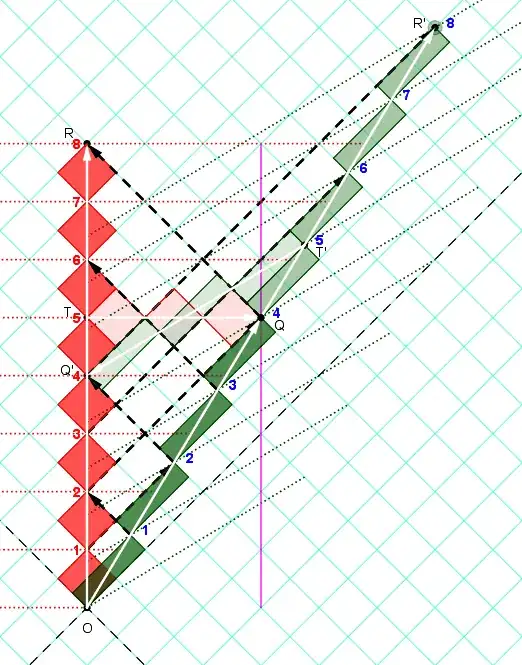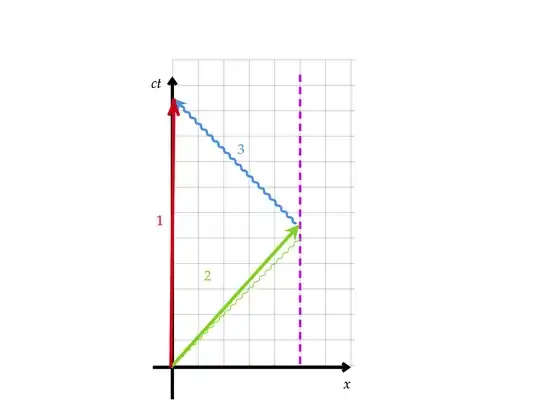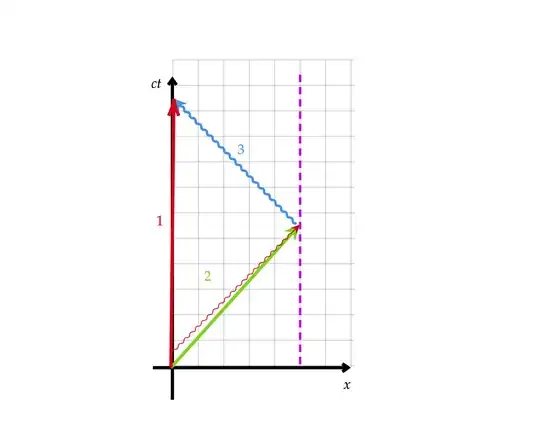Here's the situation for the arithmetically-simpler $v=3/5$ case.
I provide the equivalent values for $v=0.9$ that @J.Murray had determined earlier.
With this choice of velocity (leading to a Doppler factor $k=\sqrt{\frac{1+v}{1-v}}=2$)
and the use of the rotated graph paper, it is easy to read off many results.
The light-clock diamonds are traced-out by the signals in an observer's light-clock.
(The areas of all clock diamonds are equal by Lorentz invariance.)
Some results:
First, the velocity of the ship according to the earth is
$\displaystyle v_{SE}=\frac{TQ}{OT}=\frac{3}{5}$,
where $T$ and $Q$ are simultaneous according to the earth
and the velocity of the earth according to the ship is
$\displaystyle v_{ES}=\frac{T'Q'}{OT'}=\frac{-3}{5}$,
where $T'$ and $Q'$ are simultaneous according to the ship.

When the ship reaches the planet at event $Q$,
4 ticks have elapsed for the ship, and ship's clock-face display has been broadcast to the earth.
The earth receives that image of "4 on the ship clock" at event $R$ 8 ticks after separation at event O.
This ratio $\displaystyle \frac{OR}{OQ}= \frac{8}{4}=2$ is the Doppler factor $\displaystyle k=\sqrt{\frac{1+v}{1-v}}$. (Note that $QR$ is a light-signal.)
(For $v=9/10$, we have $k=\sqrt{19}\approx 4.3588$, which is consistent with @J.Murray's $\displaystyle\frac{21.11}{4.843}$.)
Said another way... if the ship broadcasted 1-hour tv shows, the earth views those shows running at half-speed (taking the earth 2 hours to view the content of the ship's 1-hour show).
Note that if the earth broadcasted 1-hr tv shows, the ship would also view them at half-speed. In fact, the ship receives the image of "4 on the earth clock" (broadcast at event $Q'$) at event $R'$ 8 ticks after separation at event O---in accordance with the Principle of Relativity for these two inertial observers.
Events connected by light-signals are associated with the Doppler effect.
Contrast this with....
Events connected by lines-of-simultaneity are associated with the Time-Dilation effect.
The earth says that distant event $Q$ (when the ship reaches the planet, when the ship clock reads 4 ticks) is simultaneous with local event $T$ on the earth worldline. ($TQ$ is parallel to the spacelike-diagonal of the earth's light-clock diamonds.)
The ratio $\displaystyle\frac{OT}{OQ}=\frac{5}{4}$ is the time-dilation factor $\displaystyle\gamma=\frac{1}{\sqrt{1-v^2}}$.
($TQ$ is on the earth's line-of-simultaneity.)
(For $v=9/10$, we have $\gamma=\sqrt{\frac{100}{19}}\approx 2.294$, which is consistent with @J.Murray's $\displaystyle\frac{11.11}{4.843}$, as stated there.)
Operationally, the local event $T$ is determined by a radar experiment by the earth to measure distant event $Q$. The earth sends a light-signal that reaches $Q$ and awaits its echo. The mid-time event between transmission (at 2 ticks) and reception (at 8 ticks) determines that the event at $\frac{1}{2}(8+2)=5$ ticks is simultaneous with $Q$.
Since the earth says $T$ and $Q$ are simultaneous,
signals emitted (from firecrackers exploding at $T$ and $Q$) are received at a common event
that the earth says is midway, at $\frac{1}{2}TQ=\frac{1}{2}3=\frac{3}{2}$,
at a time $\frac{3}{2}$ later (the event at $(t,x)=(6.5,1.5)$ according to the earth).
(This event is the future-intersection of the light-cone of event $T$ and the light-cone of event $Q$.)
The earth can actually use this radar information to determine the elapsed time $OQ$ on the remote segment of the ship's worldline: $OQ=\sqrt{(8)(2)}=4$. (This follows from $\Delta t= (t_{rec}+t_{send})/2$ and $\Delta x= (t_{rec}-t_{send})/2$. Then $t_{rec}t_{send}=\Delta t^2 -\Delta x^2$. By the way, the ship would say $OQ=\sqrt{(4)(4)}=4$ using a very short radar experiment to measure $Q$.)
(For $v=9/10$, the earth would send at 1.11111 ticks and receive at 21.11111 ticks.
Then $\sqrt{(21.11111)(1.11111)}=4.843$, as @J.Murray calculated.)
In accordance with the principle of relativity,
I think you can see
that
the ship says that distant event $Q'$ (when the earth clock reads 4) is simultaneous with local event $T'$ (at 5 ticks) on the ship worldline. ($T'Q'$ is parallel to the spacelike-diagonal of the ships's light-clock diamonds.) The ship would obtain all of the results measuring the earth that the earth did measuring the ship.
...all completely symmetric for these inertial observers, in accordance with the principle of relativity.
Hopefully, this visualization (motivated by the light-clock and other relativistic concepts) encodes and summarizes these and other results
in a numerically accurate and physically interpretable way.
For more aspects of this symmetry,
consult my answer https://physics.stackexchange.com/a/383363/148184
and other answers
from
How can time dilation be symmetric?
Finally, as mentioned in the comments to the OP,
this problem is really about the symmetry of time-dilation---not
the clock-effect/twin-paradox involving a non-inertial twin that reunites with the first twin.


